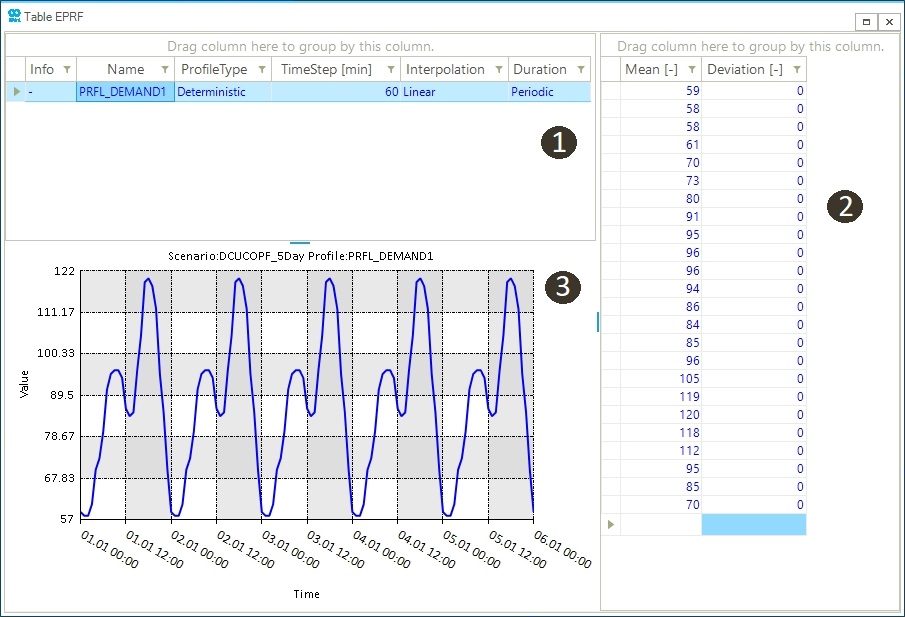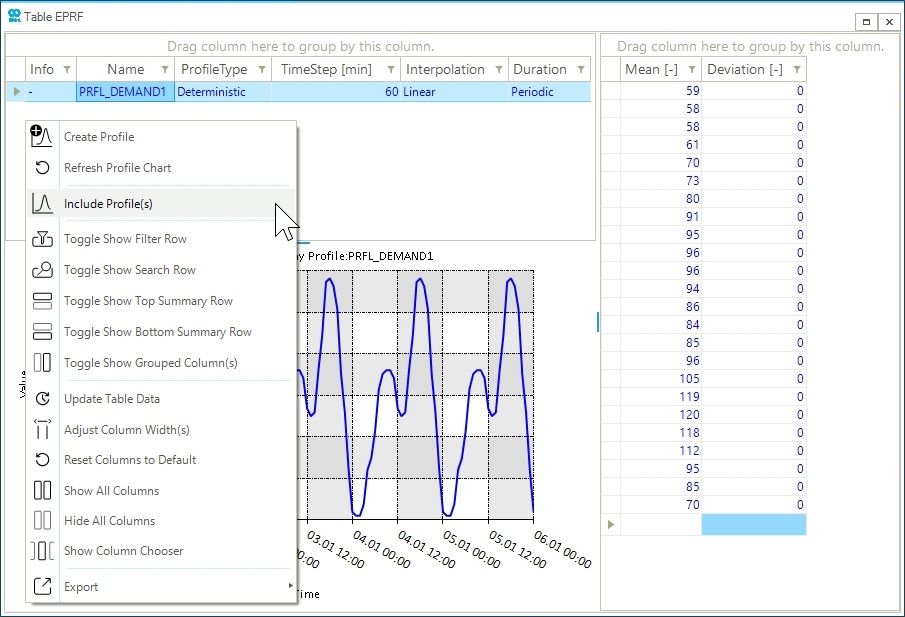Step 5: Define Scenario Profiles
Dynamic or time-dependent variables in SAInt are modeled using a scenario profile. Each profile is composed of equidistant data points describing an object’s property change over time. This step will focus on developing profiles to define the demand and wind production of the system in the SAInt GUI. The tutorial objective is to understand how different properties affect a profile and visualize, create, and edit profile data points.
1. Open the profile table
For this market optimization, the two demand objects and the wind generator will be modeled with time series data and implemented as profiles. Open the profile table by going to the scenario tab and selecting EPRF. The profile table is separated into three main sections, as shown in Figure 1.
-
Profile description table (❶), this section allows the user to see and edit the properties of the profiles; this includes properties such as the profile name, type, and time step. Additionally, you can directly create and delete profiles for the scenario file.
-
Profile data table (❷), this section displays the time series data points of the currently selected profile (highlighted in blue in section 1). Here you can directly edit the profile time series by changing, adding, or removing any cell of the profile data series. The data
Meancolumn must be filled to define the profile’s data points, while theDeviationcolumn is only used for stochastic profiles. -
Profile chart window (❸), this section plots the values of the profile data points against the scenario time window to visualize the dynamic behavior of the currently selected profile.

2. Create a profile
You will now create the profile shown in Figure 1.
Go to the profile description table, right-click, and select Create Profile.
A new profile will appear, and you can now edit the profile properties.
For the first profile, you will use edit the profile’s name to PRFL_DEMAND1, by typing it under the Name column.
Verify the following properties.
-
ProfileTypeDeterministic -
TimeStep60 [min] -
DurationPeriodic
3. Enter and visualize profile data
By default, you will notice that a new profile is created with a value of 1.
Now, you will edit the profile data points in the profile data table (section 2).
Under the Mean column, enter the corresponding data points for the PRFL_DEMAND1 provided in Table 1.
You can edit profile data points manually by selecting the desired cell, then overwriting the value and pressing Enter to save the new value in the cell. Press Down to select the following row and repeat the process. However, while adding new data points to the profile data series pressing Enter will automatically jump to the following cell.
Click here to view profile data.
| PRFL_DEMAND1 | PRFL_DEMAND2 | PRFL_WIND_GEN3 |
|---|---|---|
Mean |
Mean |
Mean |
59 |
92 |
0.12 |
58 |
97 |
0.25 |
58 |
88 |
0.35 |
61 |
103 |
0.4 |
70 |
97 |
0.6 |
73 |
0.77 |
|
80 |
0.76 |
|
91 |
0.74 |
|
95 |
0.72 |
|
96 |
0.75 |
|
96 |
0.73 |
|
94 |
0.71 |
|
86 |
0.7 |
|
84 |
0.54 |
|
85 |
0.5 |
|
96 |
0.21 |
|
105 |
0.18 |
|
119 |
0.25 |
|
120 |
0.21 |
|
118 |
0.25 |
|
112 |
0.45 |
|
95 |
0.42 |
|
85 |
0.2 |
|
70 |
0.12 |
4. Include profile data
Instead of repeating the same manual process for the other two profiles, you will use the include feature to input the profiles from an existing profile file (.prfl).
Before continuing with the following steps, make sure you have a copy of the file "Profile_data.prfl" from the directory of the tutorial.
The file provides the profile data for DEMAND2 and WIND_GEN3.
In the profile description table, right-click on the blank space and select Include Profile(s), as shown in Figure 2.
This procedure will open a window asking which profile file to open.
Locate the profile file from the zip folder and press Open.
A prompt that the profiles have been successfully loaded should appear.
Press OK or close the window to continue.

We can now observe that two new profiles have been included in the scenario file.
PRFL_DEMAND2 is a daily demand profile with TimeStep of 1440 minutes and a Step Interpolation.
PRFL_WIND_GEN3 is an hourly normalized wind production profile.